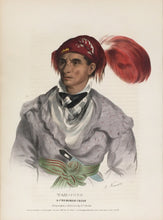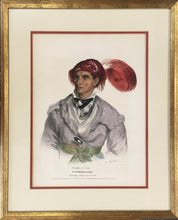Charles Bird King (1785-1862). “Tahchee. A Cherokee Chief.”
From McKenney & Hall’s History of the Indian Tribes of North America. Philadelphia: E. C. Biddle, 1837. 1842. Folio edition. Lithograph by A. Newsom. Full original hand coloring. Includes original text from publication. Faint transference of text surrounding image. Else, very good condition. Not examined out of frame. Sold as is. A/A
A series of striking prints from McKenney & Hall’s impressive portfolio of Indian portraits. These prints document an important part of American History, the great leaders of the Indian nations which have disappeared since the mid-nineteenth century. Thomas McKenney, head of the United States Bureau of Indian Affairs for many years, was a champion of the Indian and fought throughout his tenure to preserve something of their culture, so integral a part of the history of the United States. His legacy was a gallery of portraits of the great chiefs by artists such as James Otto Lewis, Charles Bird King and George Cooke.
McKenney took office in 1816 and shortly thereafter began to plan an archive which would house Indian memorabilia. In the winter of 1821-22 a large delegation of Indians comprising Pawnee, Sauk, Fox, Menominee, Miami, Sioux, and Chippewa came to Washington to see President Monroe. McKenney took advantage of this opportune time to record their likenesses by commissioning Lewis and King. More paintings were added to these over the years resulting in an impressive gallery of Indian portraiture. In 1830, McKenney was dismissed by President Jackson and at this time began to plan for the publication of a portfolio of prints of these portraits.
The results of years of struggle, McKenney’s folio was completed 6 years later, the plates for the first edition being first published in 1832. The folio was a collaborative effort, the text written by James Hall based on information which McKenney supplied. The magnitude of the project was overwhelming. McKenney battled poverty, politics, and printers to achieve his goal. Although he was acutely aware that he was preserving a chapter in history, he could not have known that had he not undertaken this project that no record at all would remain for in 1865 a fire at the Smithsonian destroyed almost all the original paintings from which the lithographs were drawn. Photography provided a record of the post-Civil War frontier but for the pre-Civil War period we have the artists and the visionaries, such as McKenney, who captured the brilliance of Indian culture in that brief period in history before much of it was forever lost.





